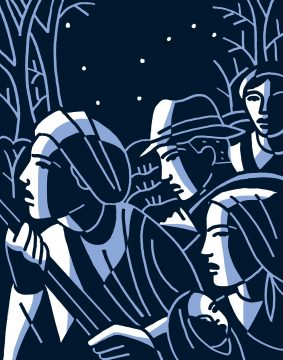Julian Lucas in The New Yorker:
 A gunshot echoed over starlit forest near the town of Marine on St. Croix, Minnesota. It was late October, already frigid, and chasers had pushed our group of ten fugitives to the edge of a lake. For a moment, we’d hesitated, shouts drawing closer as the black water winked, but the shot drove us all straight in. My legs went numb; Elyse, a high-school sophomore, exclaimed, “My God! ” Submerged to the waist, I waded through marsh grass and lamplight toward our conductor, who silently indicated the opposite bank. The Drinking Gourd shone overhead with exaggerated clarity. This was my third Underground Railroad Reënactment.
A gunshot echoed over starlit forest near the town of Marine on St. Croix, Minnesota. It was late October, already frigid, and chasers had pushed our group of ten fugitives to the edge of a lake. For a moment, we’d hesitated, shouts drawing closer as the black water winked, but the shot drove us all straight in. My legs went numb; Elyse, a high-school sophomore, exclaimed, “My God! ” Submerged to the waist, I waded through marsh grass and lamplight toward our conductor, who silently indicated the opposite bank. The Drinking Gourd shone overhead with exaggerated clarity. This was my third Underground Railroad Reënactment.
An hour had elapsed by the time we crossed the lake: seven teens, two elementary-school teachers, one “abolitionist,” and me. I had no idea where we were, only that it was about two hundred miles from Canada, where Justin Trudeau had just won reëlection after a blackface scandal, and forty from the waters of Lake Minnetonka, in which Prince orders Apollonia to “purify” herself in “Purple Rain.” As we stepped ashore, I thought of my enslaved forebears, wondering what they might make of our strange tribute. “That’s what you’re concerned about, your ChapStick?” Elyse chided Max, a blond boy in a blue hat and checkered Vans. His lip balm was ruined—as was my notebook—but the baby doll he’d sworn to carry North was dry. (Elyse dubbed him Mother Max.) The whispers stopped with the arrival of our conductor, who led us on a rough path uphill. I was still smarting from a branch to the forehead when he stopped to deliver the night’s sixth lecture: “My name is Henry David Thoreau. This is Walden Pond.”
More here. (Note: Throughout February, at least one post will honor The Black History Month. This year’s theme is “African Americans and the Vote.” Readers are encouraged to send in their suggestions)
